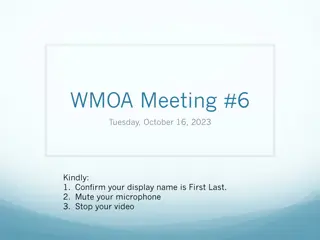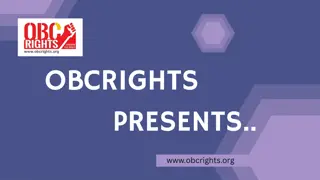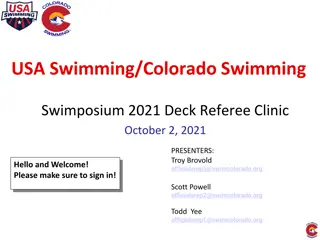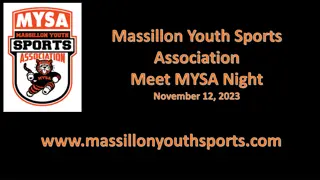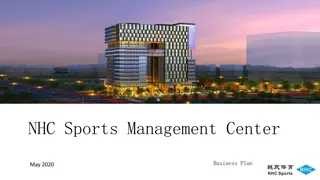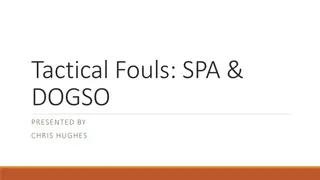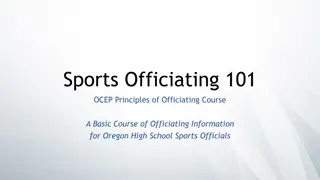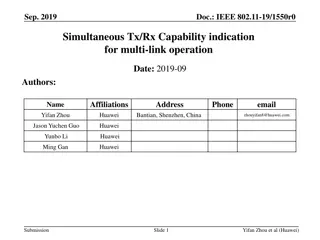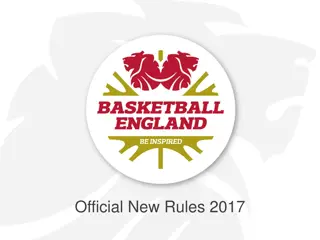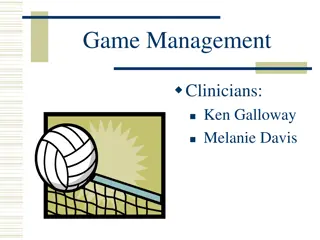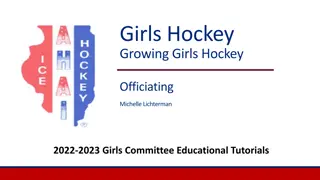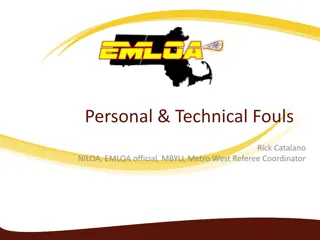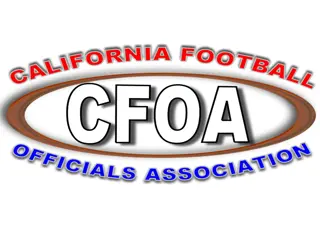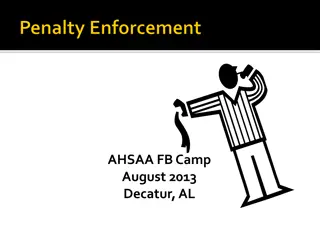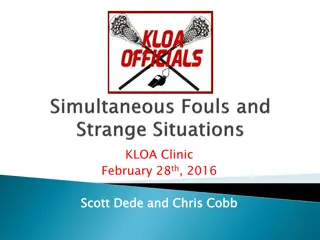Simultaneous Fouls in Sports Officiating
Explore the concept of simultaneous fouls in sports officiating, including their definition, rule application, and impacts on gameplay. Learn how to determine when fouls occur, differentiate live ball and dead ball fouls, and identify the first offender in simultaneous live ball fouls. Gain insights into how fouls affect play continuation and ball possession based on penalty time. Enhance your knowledge of officiating rules and procedures in sports.
Download Presentation

Please find below an Image/Link to download the presentation.
The content on the website is provided AS IS for your information and personal use only. It may not be sold, licensed, or shared on other websites without obtaining consent from the author.If you encounter any issues during the download, it is possible that the publisher has removed the file from their server.
You are allowed to download the files provided on this website for personal or commercial use, subject to the condition that they are used lawfully. All files are the property of their respective owners.
The content on the website is provided AS IS for your information and personal use only. It may not be sold, licensed, or shared on other websites without obtaining consent from the author.
E N D
Presentation Transcript
Simultaneous Fouls NJILOA 2019 Meeting #3
Whos Here a) Cadet (1-2 Years) b) Newer Official (3-5 Years) c) Experienced Official (6-9 Years) d) Grizzly Veteran (10+ Years)
Agree Or Disagree Simultaneous fouls are only labeled that way because they occur at the exact same time a) Agree b) Disagree
Defining Simultaneous Fouls What Does the Rule Say? Answer In English: Rule 7-6: Simultaneous fouls are fouls called on players of opposing teams during: Simultaneous fouls happen when you have at least one foul on each team. A live ball; or A dead ball when sequence cannot be determined AND The thing that makes them simultaneous, is that their penalties START at the same time NOTE: Most live-ball simultaneous fouls do not occur at the exact same time
The Question We Must Ask First: When Did the Fouls Occur? This is What We Need to Know to Dissect the Play in Real Time
Answering WHEN: Are They.. All Live Ball Fouls: At Least Some of Them Happened During Dead Ball Time: This means that all the fouls on the play took place while live play was still going on. If any or all the fouls on the play took place during dead ball time, this causes us to apply a different process to figure out who gets the ball, and where. This causes us to apply one kind of process to figure out who gets the ball, and where.
Simultaneous Live Ball Fouls: There is one thing for certain which happens every time there are simultaneous live ball fouls: a) The first offender s name is always Billy b) The defense commits the first foul c) The offense commits the first foul d) Everyone is confused
The Verdict Answer: b) the defense commits the first foul This allows play to continue under a slow whistle. If the offense is the team that commits the first foul, the play is killed immediately, which creates live-ball, dead-ball
The foul by the offense (the second infraction) kills the play The team with less penalty time gets the ball Live Ball Fouls If the penalty time is equal, the offense gets to keep it Know the Rules of Engagement The team getting the ball will restart at the spot the play was stopped, even if that means they have to clear it
Scenario: Lenny scoops up a ground ball, and is in the process of picking his head up. A player on the opposing team, Billy, runs from five yards away and takes Len out, knocking him off his feet with a body check before Lenny can adjust. Lenny s teammate, Larry, is upset with the hit, and slashes Billy in the arm guard. You throw two flags and kill the play. Let s Examine The Outcome
A) Unnecessary Roughness - 1 minute, releasable B) Unnecessary Roughness - 1 minute, non-releasable C) Blindsiding - 2 minutes, non-releasable D) Illegal Body Check, hit on a defenseless player - 2 minutes, non-releasable What is Billy s Foul:
Answer: C) Blindsiding - 2 minutes, non-releasable ** Letter D is the old verbiage from previous years. Though Answers C and D describe the exact same action, the verbiage in letter C is the correct terminology for 2019. The mechanic is a balled up first into your lower back The Verdict...
A) Targeting, Ejection Foul, 3-minutes non- releasable B) Slashing - 1 minute, releasable C) Slashing - 1 minute, non-releasable What is Larry s Foul:
Answer: C) Slashing - 1 minute, non-releasable ** By rule, because the fouls are simultaneous, the least amount of time served by any of the players shall be non-releasable for all players who are serving penalty time The Verdict...
Who Gets The Ball? Lenny / Larry s Team Billy s Team
Where Shall The Restart Occur? Spot of the Stoppage Free Clear if in Defensive End
Live-Ball, Dead-Ball Or Dead-Ball, Dead-Ball Fouls Think of a whistle to stop play as a wall being constructed between segments of the play Everything on the other side of the wall, sequence of the fouls determines possession Don t know sequence? Total foul time determines possession Know the Rules of Engagement Restart: Live-ball, dead ball, dead center.
Scenario: Larry, a midfielder, is clearing the ball from his defensive end. On the opposing team, Billy chases him and runs offside flag down. The play continues, and the ball becomes loose. During the flag-down, slow-whistle situation, Larry receives a very heavy check on his hands, just as Billy is scooping up the ground ball to end the slow whistle. After you blow the whistle to stop play, thinking he has been slashed, Larry shouts into the silence at the official, asking him, Are you going to _______ ing call something?? Let s Examine The Outcome
a) Conduct foul, 30 seconds releasable b) Unsportsmanlike Conduct, 1-minute releasable c) Unsportsmanlike Conduct, 1 minute non- releasable d) No penalty Larry s Penalty
a) Offside, 30 seconds releasable b) Offside, 30 seconds non-releasable c) No penalty Billy s Penalty
Who Gets The Ball? Larry s Team Billy s Team
Larry Billy Answer: C) USC - 1 minute, non- releasable Answer: B) Offside, 30 seconds non-releasable Don t scream into the silence. Don t scream into the silence and use profanities. Unsportsmanlike conduct for misconduct shall always be non- releasable for the duration of the foul. By rule, Billy s offside penalty becomes non-releasable because it is part of simultaneous fouls. The Verdict... Though it s true that Billy had less penalty time than Larry, that s not the reason Billy s team gets the ball. Billy s team gets the ball because Larry s foul occurred during the dead ball period. By rule, restart the ball at the center X
Scenario: (This actually happened in a game) Lenny is running to the goal and is held by Billy, flag down. The play continues, and Lenny weaves through traffic and scores. As the trail official, you jog over to the table to report that the goal is good and the penalty is wiped out. But, as you are in mid-sentence, Billy s coach requests that you check Lenny s stick. You stop what you re doing, look directly at Lenny and say, Lenny! Don t touch your stick! Lenny then promptly pulls the strings of his stick, tightening the depth of his pocket before you can take his stick from him. What To Do Next...
A) Throw a flag, illegal crosse. 1-minute non releasable. No need to check the stick. B) Throw a flag, illegal crosse. 3-minutes non releasable. No need to check the stick. C) Throw a flag, unsportsmanlike conduct. 1-minute non releasable. No need to check the stick. D) Throw a flag, unsportsmanlike conduct. 1-minute non releasable. Check the stick and penalize further if necessary. What Is Your Next Move?
Answer: D) Throw a flag, unsportsmanlike conduct. 1-minute non releasable. Check the stick and penalize further if necessary ** 5-5-D: During the game, an official asks a player for his crosse so the official can check it. Before the player hands the crosse to the official, he adjusts the strings or jams the crosse. Ruling: A 1-minute, non-releasable unsportsmanlike conduct penalty shall be served. If the player with the adjusted crosse scored a goal just before the crosse inspection ( stick check ) the goal is disallowed. The crosse is then inspected and penalized an additional 1-3 minutes if violations are found. The Verdict...
Dont Forget Billy s Hold The hold was going to be wiped out by the goal. But, because Lenny s goal is wiped out by the USC foul, the hold is reinstated This is a multi-layered process Who Gets the Ball? Where is the restart?
Who Gets The Ball? Lenny s Team Billy s Team
Where Shall The Restart Occur? Outside the Box in Defensive End Free Clear




